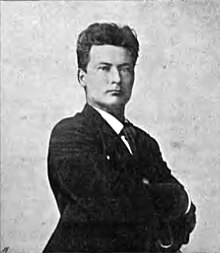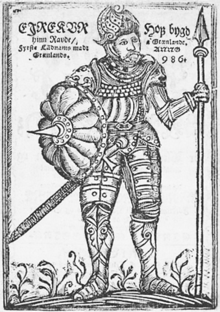Portal:Iceland/Selected biography
| This Wikipedia page has been superseded by Portal:Iceland and is retained primarily for historical reference. |
| Note: Article entries are now being transcluded directly on the main portal page. However, this page should be retained for historical reference. |
Usage
The template used to format these sub-pages is located at {{Selected biography}}.
- Add a new selected picture to the next available subpage.
- Update
"max="to new total for its{{Random portal component}}on the main page.
Selected biography 1
Portal:Iceland/Selected biography/1
Vigdís Finnbogadóttir (Icelandic: [ˈvɪɣtis ˈfɪnpɔɣaˌtouʰtɪr̥] ⓘ; born 15 April 1930) is an Icelandic politician who served as the fourth president of Iceland from 1980 to 1996. Vigdís is the first woman in the world to be democratically elected as president. Having served as president of Iceland for 16 years, she is the longest-serving elected female head of state in history. She is to date Iceland's only female President. Vigdís is a UNESCO Goodwill Ambassador and a member of the Club of Madrid. (Full article...)
Selected biography 2
Portal:Iceland/Selected biography/2
Björk Guðmundsdóttir OTF (/bjɜːrk/ BYURK, Icelandic: [pjœr̥k ˈkvʏðmʏntsˌtouhtɪr̥] ⓘ; born 21 November 1965) is an Icelandic singer, songwriter, composer, record producer, and actress. Noted for her distinct voice, three-octave vocal range, and sometimes eccentric public persona, she has developed an eclectic musical style over a career spanning four decades, drawing on electronic, pop, experimental, trip hop, classical, and avant-garde music.
Born and raised in Reykjavík, Björk began her music career at the age of 11 and gained international recognition as the lead singer of the alternative rock band the Sugarcubes by the age of 21. After the Sugarcubes disbanded in 1992, Björk gained prominence as a solo artist with her albums Debut (1993), Post (1995), and Homogenic (1997), collaborating with artists from a range of disciplines and genres, and exploring a variety of multimedia projects. Her later, post-nineties, albums consist of Vespertine (2001), Medúlla (2004), Volta (2007), Biophilia (2011), Vulnicura (2015), Utopia (2017) and Fossora (2022). (Full article...)
Selected biography 3
Portal:Iceland/Selected biography/3
Arnaldur Indriðason (pronounced [ˈartnaltʏr ˈɪntrɪðasɔn]; born 28 January 1961) is an Icelandic writer of crime fiction; his most popular series features the protagonist Detective Erlendur. (Full article...) Arnaldur Indriðason (born 28 January 1961) is an Icelandic writer of crime fiction. He has repeatedly proved to be the most popular writer in Iceland in recent years – topping bestseller lists year after year. In the year 2004 his books were seven of the ten most popular titles borrowed in Reykjavík City Library. Arnaldur's books have been published in 26 countries and have been translated into German, Danish, English, Italian, Czech, Swedish, Norwegian, Dutch, Finnish and French. Indriðason received the Glass Key, a literature prize for the best Nordic crime novel, in both 2002 and 2003. He won the Gold Dagger Award in 2005 for the novel Silence of the Grave.
Selected biography 4
Portal:Iceland/Selected biography/4 Ásmundur Sveinsson was an Icelandic sculptor, was born at Kolsstadir in West Iceland on May 20, 1893 and died in Reykjavík on December 9, 1982. His themes were often men and women at work and included such pieces as, The Blacksmith, The Washer Women and The Water Carrier. During the 1940s Ásmundur's work moved even farther away from the human and animal form that had been his mainstay until then and by the 1950s he was producing work that was almost entirely abstract. Like many Icelandic artists Ásmundur drew upon the traditions of his native country when seeking subjects to inspire him. These include Trollwoman, (1948), Head Ransom, (1948), based on a poem that Egil Skallagrimsson composed to save his own head and Hell-Ride, (1944) taken from the Prose Edda of Snorri Sturlusson.
Selected biography 5
Portal:Iceland/Selected biography/5

Davíð Oddsson (pronounced [ˈtaːvið ˈɔtːsɔn]; born 17 January 1948) is an Icelandic politician, and the longest-serving prime minister of Iceland, in office from 1991 to 2004. From 2004 to 2005 he served as foreign minister. Previously, he was Mayor of Reykjavík from 1982 to 1991, and he chaired the board of governors of the Central Bank of Iceland from 2005 to 2009. The collapse of Iceland's banking system led to vocal demands for his resignation, both from members of the Icelandic public and from the new Icelandic Prime Minister Jóhanna Sigurðardóttir, which resulted in his being replaced as head of the Central Bank in March 2009. In September 2009 he was hired as the editor of Morgunblaðið, one of Iceland's largest newspapers, a decision that caused nationwide controversy and was followed by resignations and widespread terminated subscriptions. He contested the election for President of Iceland on 25 June 2016 but lost to Guðni Jóhannesson. (Full article...)
Selected biography 6
Portal:Iceland/Selected biography/6
Einar Jónsson (11 May 1874 – 18 October 1954) was an Icelandic sculptor, born in Galtafell, a farm in southern Iceland. (Full article...) Einar Jónsson (May 11, 1874 – October 18, 1954) was an Icelandic sculptor, born in Galtafell, a farm in southern Iceland. Unlike most other sculptors, Einar worked almost entirely in plaster. This had to do partly with the lack of good modeling clay in Iceland, but it allowed Einar to work on his individual sculptures for years. Spending over a decade on a particular piece was not uncommon for him. The themes for his works—public monuments, private commissions, and private works—are frequently drawn from Norse mythology and Icelandic folk tales. Einar's world is populated by angels and trolls, by beautiful women and bold warriors, and most of all a layer of symbolic content that can invariably be felt, but not always understood.
Selected biography 7
Portal:Iceland/Selected biography/7
Erik Thorvaldsson (c. 950 – c. 1003), known as Erik the Red, was a Norse explorer, described in medieval and Icelandic saga sources as having founded the first European settlement in Greenland. Erik most likely earned the epithet "the Red" due to the color of his hair and beard. According to Icelandic sagas, Erik was born in the Jæren district of Rogaland, Norway, as the son of Thorvald Asvaldsson; to which Thorvald would later be banished from Norway, and would sail west to Iceland with Erik and his family. During Erik's life in Iceland, he married Þjódhild Jorundsdottir and would have four children, with one of Erik's sons being the well-known Icelandic explorer Leif Erikson. Around the year of 982, Erik was exiled from Iceland for three years, during which time he explored Greenland, eventually culminating in his founding of the first successful European settlement on the island. Erik would later die there around 1003 CE during a winter epidemic. (Full article...) Erik the Red (950–c. 1003) founded the first Nordic settlement in Greenland. Born in the Jæren district of Rogaland, Norway as the son of Þorvaldr Ásvaldsson (Thorvald Asvaldsson), he therefore also appears, patronymically, as Erik Thorvaldsson (or as Eiríkr Þorvaldsson). The appellation the Red most likely refers to his hair color. Erik the Red had to flee Norway because of "some killings", as The Saga of Eric the Red recounts. He and his family settled in Iceland. The Icelanders later exiled Erik for several murders around the year 982.
Selected biography 8
Portal:Iceland/Selected biography/8
Geir Hilmar Haarde (Icelandic pronunciation: [ˈceːir̥ ˈhɪlmar̥ ˈhɔrtɛ]; born 8 April 1951) is an Icelandic politician, who served as prime minister of Iceland from 15 June 2006 to 1 February 2009 and as president of the Nordic Council in 1995. Geir was chairman of the Icelandic Independence Party from 2005 to 2009. Since 23 February 2015 he has served as the ambassador of Iceland to the United States and several Latin American countries.
Geir initially led a coalition between his party and the Progressive Party. After the 2007 parliamentary election, in which the Independence Party increased its share of the vote, Geir renewed his term as prime minister, leading a coalition between his party and the Social Democratic Alliance. That coalition resigned in January 2009 after widespread protests following an economic collapse in October 2008. In September 2010, Geir became the first Icelandic minister to be indicted for misconduct in office, and stood trial before the Landsdómur, a special court for such cases. He was convicted on one count, but acquitted of the most serious violations. (Full article...)
Selected biography 9
Portal:Iceland/Selected biography/9
Halldór Kiljan Laxness (Icelandic: [ˈhaltour ˈcʰɪljan ˈlaksnɛs] ⓘ; born Halldór Guðjónsson; 23 April 1902 – 8 February 1998) was an Icelandic writer and winner of the 1955 Nobel Prize in Literature. He wrote novels, poetry, newspaper articles, essays, plays, travelogues and short stories. Writers who influenced Laxness included August Strindberg, Sigmund Freud, Knut Hamsun, Sinclair Lewis, Upton Sinclair, Bertolt Brecht and Ernest Hemingway. (Full article...)
Selected biography 10
Portal:Iceland/Selected biography/10
Jón Sigurðsson (17 June 1811 – 7 December 1879) was the leader of the 19th century Icelandic independence movement. (Full article...) Jón Sigurðsson (June 17, 1811 – December 7, 1879) was the leader of the 19th century Icelandic independence movement. He is often referred to as President (Jón forseti) by Icelanders. The main reason for this is that since 1851 he served as President of the Copenhagen Department of Hið íslenska bókmenntafélag (the Icelandic Literature Society). He was also the president of Althing several times, for the first time in 1849. He is currently pictured on Iceland's 500 krónur bill, and has been honoured on Icelandic postage stamps on the centenaries of his birth and death, the 150th anniversary of his birth, and on the creation of the Republic of Iceland (on his 133rd birthday).
Selected biography 11
Nominations
Feel free to add any featured articles to the list above. You can also nominate other articles relating to Icelandic people here.








